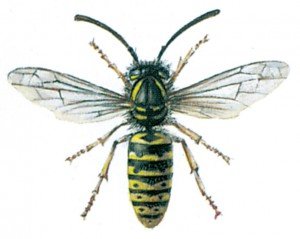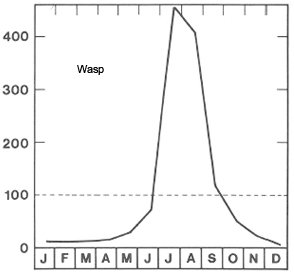Latin: Vespoides spp.


The wasp is a wide category that covers digger wasps, parasitic wasps, hornets etc. Wasps are well known in their black and yellow striped abdomens and no less for their ability to sting. In Northern Europe there are about a dozen species of social wasps, which are very similar to each other both in way of life and appearances.
At our latitude wasp colonies are annual. This means that the nests are only used the year they are built. Old nests from earlier years are empty. It is the young, fertilized queens that overwinter. They wake of hibernation in April and all alone they start the process of founding a new colony. In late May, the first workers are on their wings and then each society steadily grows until August, when there are about 5,000 individuals. The nests are usually spherical. It is built by a paper-like material that the wasps make of wood fibre chewed with saliva. The larvae feed exclusively on meat. Their preys are mostly insects, which the adults catch for them, or it may be chunks of meat that adults bite of carrion. In exchange for the meat chunk that the larvae receive, it regurgitates a sugary liquid up which the adult wasp eagerly eats. The adult wasps primarily live of sugar in the form of nectar, aphid excrement and the like. In the autumn the machinery of their society gets messed up. Workers stops taking care of the larvae and live from that time on by doing nothing until the frost takes them. Most of the summer wasps are not particularly visible. They are busy building their nest and gathering food for their offspring. At that time, they can also get meat from butchers and fishmongers.
In the late summer the wasps become bothersome everywhere. This is partly because the number of individuals now has become quite high and partly because the workers no longer take care of the larvae and they rather find sugar or sweet juice wherever this can be found. It is particularly amongst bakers and greengrocers, at ice cream parlours, etc. as well as place where people eat outdoors.

In businesses and in stores where it is not possible to keep wasps effectively out, light traps with ultraviolet light, where the wasps are captured or killed, clear the problem. The most rational way to fight a local wasp infestation is to find and neutralise the nest. Nests may be sprayed with an insecticide from the bottom up through the entrance hole. You wait until late in the evening when the wasps are all home and are relatively quiet. If the nest is hidden in a cavity wall or in the ground, you can dust the hole or the slot which the wasps fly in and out of, with an insect powder. The wasps will then bring the poison into the nest and a few days later it will be dead. Wasps are aggressive towards people who tamper with their nest, so do not linger at the nest when you fight them. The nest need not be removed.




